5 Best and Effective Exercises to Treat Varicose Veins Naturally
| Author: Manoja Kalakanti
Have you been sitting for long periods without engaging in any physical activity? Check your legs for purple-colored web-like structures, most typically found on the calves and thighs. If you notice something like this, you may have varicose veins. Varicose veins affect both men and women, although we think of them as a female condition. Self-care and easy exercise for varicose veins can help alleviate symptoms and reduce the disease’s progression.
Exercise is the most effective strategy to prevent varicose veins from appearing. You’ve probably been told to exercise if you have varicose veins in your legs. Exercising regularly improves blood circulation and helps you maintain a healthy weight, which can help alleviate the unpleasant symptoms of varicose veins. Maintaining a healthy and balanced diet, as well as avoiding extra fats and salts, is essential. Scroll down to learn more about the best exercises for varicose veins prevention.
Causes Of Varicose Veins
A variety of factors can cause varicose veins. Females are more prone to varicose veins than males. Hereditary variables appear to play a role as well. The causes of varicose veins are categorized into life and behavior.
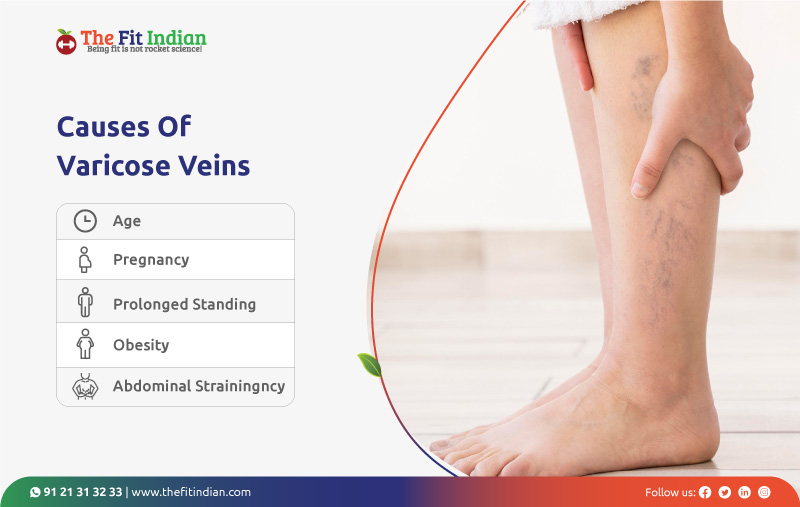
The list of people who have lived includes
- Age
- Pregnancy
- Menopause
The behavioral list includes actions or circumstances that we have control over.
- Inactivity
- Prolonged Standing
- Obesity
- Abdominal Straining
The primary cause of varicose veins is a condition known as venous reflux. This is a circumstance in which the veins experience poor or insufficient circulation.
Eating a nutritious diet and maintaining a healthy diet and exercise routine is critical for optimal health. It also happens to treat venous reflux. Getting rid of varicose veins is thus just one more reason to begin living a healthy lifestyle with varicose veins pain relief exercise.
5 Effective Exercises to Treat Varicose Veins
Modifying your lifestyle to meet the requirements of the above treatment will significantly impact your varicose veins. However, exercise will also play an essential role in controlling them. Regular exercise will increase blood flow, but it will also help you burn more calories, which will result in more weight loss. Here are the top 5 exercises for varicose veins.
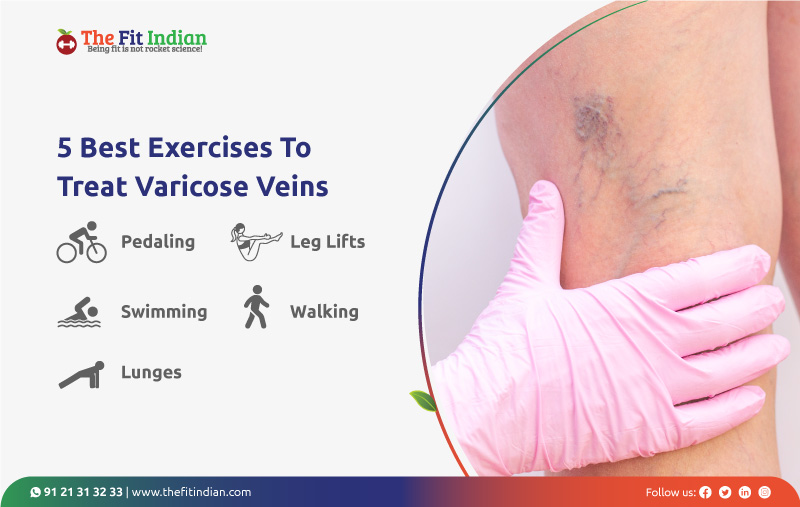
1. Pedaling
Bicycling is an excellent way to strengthen your calf muscles. Even if you can’t ride a bike, you can use a stationary bike or an elliptical machine. Even if you don’t have access to these gym machines, you can simulate the cycling motion at home. Slowly pedal your legs while lying on your back. This type of exercise is beneficial to your leg veins.
2. Leg Lifts
Leg lifts are an easy and simple exercise to do while working because most people spend their entire workday in front of their laptops, sitting in a chair. This is the best exercise for varicose veins in legs.
- Straight your back while sitting
- Raise one of your legs straight up
- Hold it for a few moments
- Reduce it gradually
- Repeat it with the opposite leg
Leg lifts can be done either sitting or standing. This type of exercise stimulates blood circulation in the veins of your legs.
3. Swimming
Swimming is another excellent aerobic activity that does not necessarily require weight-bearing. Swimming laps keep your legs at heart level, preventing blood from pooling in the lower vein valves. Leg movement also aids in the development of strong muscles and bones.
4. Walking
Varicose veins develop as a result of faulty vein valves in the legs. Walking keeps the calf muscles active, allowing blood to flow more quickly through the veins up to the heart. It is safe for older people and all ages and fitness levels because it keeps you active without straining your joints.
To maintain a healthy weight and control blood pressure and strength, try going for a 30-minute walk five times per week.
5. Lunges
Lunges work on the various muscles in your lower extremity. The leg muscles will become stronger this way and stretching improves circulation. To perform a proper lunge,
- Stand up with your legs apart
- Bend your knee and take a step forward
- Place your knee directly above your ankle
- Hold this position for a few seconds
- Return to the initial position by slowly straightening your leg
- Repeat this exercise with the other leg
- You slowly rise on tiptoes as you stand straight and then lower yourself
Use these simple yet effective exercises to save yourself from the painful problem of varicose veins. Performing these exercises throughout the day can significantly improve circulation and relieve varicose vein symptoms.
Home Remedies to Prevent Varicose Veins
A lack of certain nutrients can also cause varicose veins. The skin’s elasticity begins to deteriorate. So, people are usually encouraged to eat a well-balanced diet that provides the body with essential nutrients.
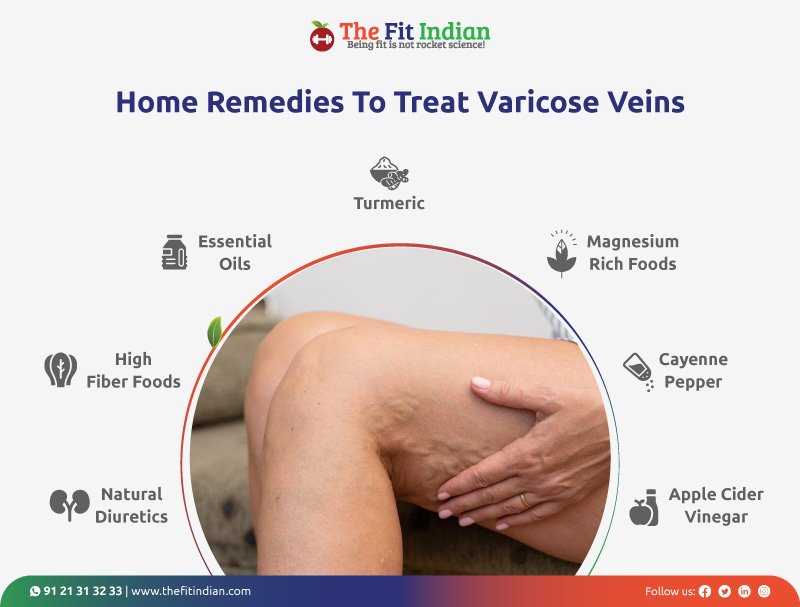
1. Essential Oils
Several essential oils increase blood flow while decreasing inflammation. The best essential oil for treating vein problems is cypress oil. Five drops of cypress essential oil applied twice daily to the affected area for up to two months should result in much less visible veins.
2. High Fiber Foods
Fiber promotes heart health and is also required for proper digestive function. Incorporating fiber daily is an excellent way to avoid constipation, which can cause bloating and increased pressure on the veins in the abdomen and legs.
- High-fiber foods to eat include
- Chia seeds
- Flaxseeds
- Vegetables
- Fresh fruits
- Soaked/sprouted legumes
- Natural Diuretics
Diuretics help to increase urination while decreasing water retention or swelling. You can achieve the same effect safely by consuming fresh herbs such as
- Parsley
- Basil
- Fennel
- Dandelion greens
- Asparagus
- Celery.
- Magnesium-Rich Foods
Blood pooling, high blood pressure, leg cramps, and painful varicose veins are all symptoms of electrolyte deficiencies such as potassium and magnesium.
- Increase your intake of magnesium-rich foods, including:
- Leafy greens
- Avocado
- Bananas
- Cruciferous veggies
- Sweet potatoes.
- Cayenne Pepper
High in vitamin C and bioflavonoids, Cayenne pepper improves blood circulation and can even help relieve the pain associated with varicose veins. When possible, use cayenne pepper in your cooking. If you’re brave, make tea with a teaspoon of ground cayenne pepper and a cup of hot water. For up to two months, drink this three times a day.
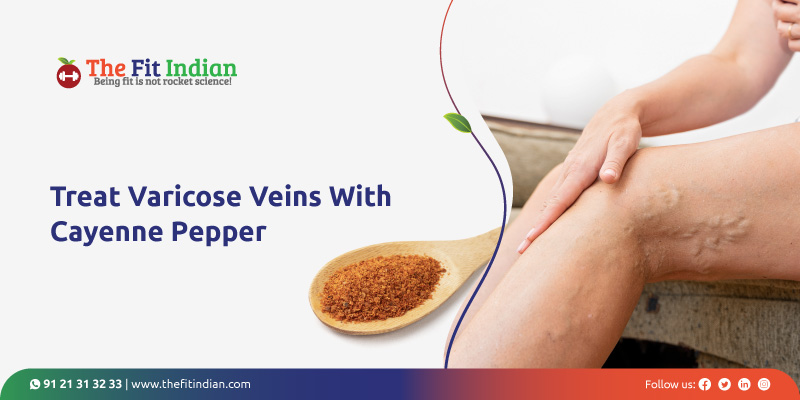
3. Apple Cider Vinegar
It’s no surprise that apple cider vinegar is on the list. Its natural cleansing properties aid in blood flow and circulation. It is used in the morning and before going to bed every night. Apply apple cider vinegar to the skin over varicose veins and gently massage the area. After a few months, you will observe a significant reduction in your varicose veins.
4. Turmeric
Turmeric is, no doubt, a miracle food. As an antioxidant, it reduces inflammation and thus pain, improves circulation, and can aid in the removal of toxins from the blood.
Make a cup of hot water and combine a teaspoon of turmeric, a teaspoon of cinnamon, a pinch of clove and nutmeg, and a teaspoon of cinnamon.
If it’s too spicy, add some raw honey to the mix, or use your favorite nut milk to make a thicker, frothier drink.
Consume a cup of turmeric tea to reduce overall inflammation, which will also help to improve your varicose veins.
These are a few home remedies for varicose veins. You can get rid of painful varicose veins in a few months by making small changes in your life and incorporating some varicose vein self-care into your morning and evening routines.
Exercises You Should Avoid If You Have Varicose Veins
While we have listed the best exercises for you if you have varicose veins, there are a few you should avoid. Any workout that exerts too much strain on the veins should be avoided.
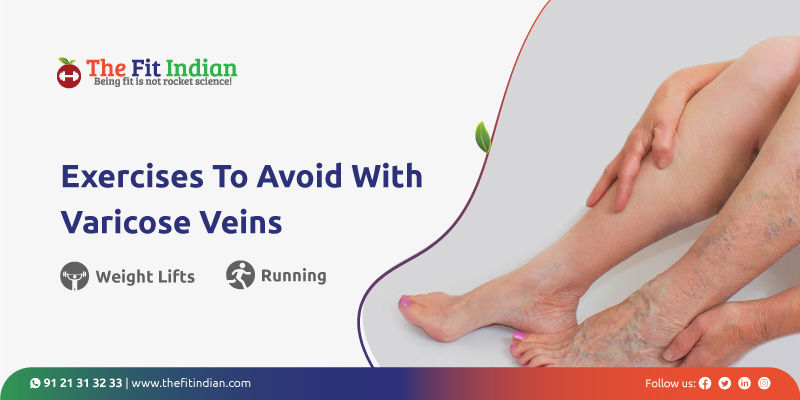
1. Weight Lifts
Lifting heavy weights strains the abdominal muscles, preventing blood flow between the legs and the heart. This pressure causes blood to pool in the veins, damaging the delicate valves.
If you still want to lift weights, switching to lighter weights, exhaling as you lift, and keeping your legs parallel or above your heart can help mitigate some of these effects.
2. Running
Although running and jogging are excellent aerobic and circulation-boosting exercises, they can tax the joints and leg veins. If you must run, avoid the hard pavement favoring softer surfaces such as grass.
Avoid squats, sit-ups, lunges, crunches and yoga exercises that require extended abdominal posturing.
Wearing compression stockings for optimal circulation is always a good idea, no matter which exercise you choose to do.
Our Take
A lack of exercise, sedentary posture, overweight, and smoking are all risk factors for vascular disease. Your vascular issues may improve if you stay active and attentive throughout the day.
Consider using an ergonomic office chair or a standing desk to make your life easier, so you don’t have to sit all day! It is critical to understand that sitting for an extended period can result in varicose veins. At the same time, it won’t be possible too often to get up and stretch your legs and take a break from your chair.
FAQ’s
1. What is the best exercise for varicose veins?
Walking is one of the most effective exercises for avoiding varicose veins. It promotes blood circulation, strengthens leg muscles, and improves blood flow throughout the body.
2. Can varicose veins be cured with exercise?
Exercise will not cure varicose veins, but it will alleviate your discomfort. While there is no way to completely prevent varicose veins, exercise will improve circulation and muscle tone, potentially lowering your risk of developing them.
3. What exercises do you avoid if you have varicose veins?
High-impact exercise may aggravate varicose veins. Tennis, football, boxing, skiing, water skiing, squash, karate, and weightlifting are also not recommended because they increase the pressure on veins.
4. Is it oK to do squats with varicose veins?
No. Squats exert more pressure on veins. So, it is not recommended to avoid squats for people with varicose veins.
5. Is jogging good for varicose veins?
Yes. Running can help prevent varicose veins by improving your blood circulation, if it is in the initial stage.
6. Does massage help varicose veins?
Massage therapy provides relief from tension and stress and soothes sore and aching muscles. It also helps the body relax and can improve circulation and prevents developing varicose veins.
7. Does ice help varicose veins?
Yes. Applying ice or a cold pack to your varicose veins can help reduce their visibility and swelling around the vein.
8. How to sleep with varicose veins?
Sleeping on your left side may help prevent the formation of varicose veins and alleviate the symptoms of existing varicose veins.
9. Can you reverse varicose veins naturally?
Yes. You can reverse varicose veins naturally with simple home remedies and a healthy diet.
10. Can walking cure varicose veins?
Yes. Walking improves varicose veins by increasing blood flow and decreasing blood pooling. Reduced blood pooling can lower blood pressure, reduce vein swelling, and prevent further deterioration of vein tissue.




Manoja Kalakanti